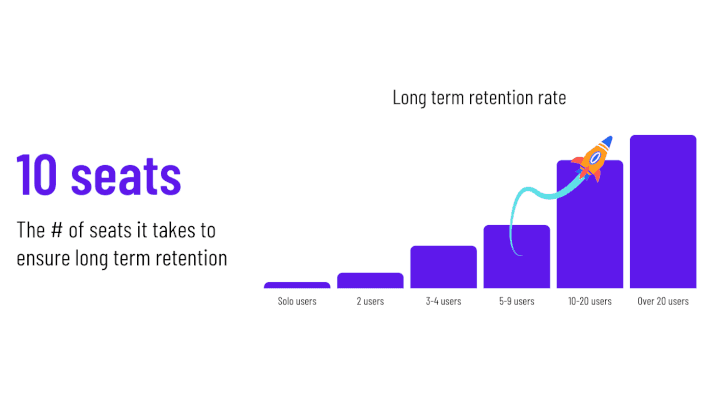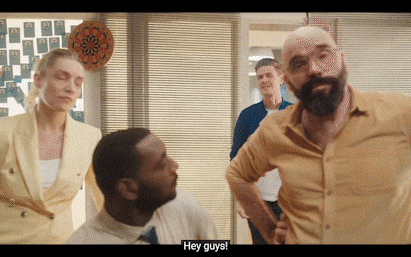At what seat size does your NRR reach escape velocity?
At what seat size does your NRR reach escape velocity?
At what seat size does your NRR reach escape velocity?
Identify the exact point where retention starts to skyrocket!
Identify the exact point where retention starts to skyrocket!
Identify the exact point where retention starts to skyrocket!



Hey, Ruchin here! Welcome back to Toplyne Labs - Edition #4
A weekly digest that covers unique insights on what makes PLG businesses tick, what signals make for the best PQLs, what sales teams get right, what they get wrong, and the meaning of life… Go figure 🤷🏻♂️
This week we crunched data from 1,785,478 teams across various categories of PLG tooling to find the exact point where Net Retention Rates (NRR) begin to hit escape velocity.
How many seats do teams/accounts need to get to, for network effects to kick into high gear?
Disclaimer: While this analysis spans over 1.8M users, it also captures a breadth of behavior across various categories of PLG products (Devtools, Creative tools, Communications, etc.). We encourage you to use these insights directionally and thematically.
Let’s look at the data.
Get your accounts to 10 or more seats
You know what’s better than an annual contract? A perpetual contract 🤩
If you’re a PLG sales or account management team, you have one job - get your accounts to 10 seats or more and you have yourself a lifelong customer.
Across inherently collaborative tools (unlike single-player tools), the value prop strengthens and grows with every subsequent user you add to your team. And often there’s a direct correlation between the # of users and long-term retention rates.
But at what point do retention rates inflect?
The answer - 10 seats

Land and… *crickets*
Collaborative tools - especially ones that have virality built into them can land and expand. While just “land” may get you many feet in many doors, what separates the best from the rest is the expansion motion. (Think: Datadog, Cloudflare, Snowflake, AWS)
Beyond the tipping point of 10 users, these teams become your largest drivers of NRR.
How do you nudge smaller teams into teams of 10+?
You’d do this by
Step 1: Identifying network effects - By measuring expansion intent through collaborative product usage events triggered by smaller teams
Jane invited 3 users to view her project
Jon referred 2 team members
Jill left a comment on Jack’s document
Step 2: Sales-assist - Identifying hand-raisers who have shown intent within your free tier to offer a product expert/specialist touch to grow smaller teams into teams of 10+.
All while walking the thin line between a great user experience and sales - because let’s face it, not everybody wants to talk to sales
Step 3: Top-down sales - With enough users in a team finding value from your product and showing intent, a sales pitch to the decision maker is a no-brainer
“Hey Jess - we were looking into your team’s activity and turns out 6 out of 15 members are power users of our product. Especially Jon and Jane 🙌🏻 Do you think centralized billing and dedicated customer success would make sense?”
All of that sounds great in theory, but how the hell do I implement this?

Hey, Ruchin here! Welcome back to Toplyne Labs - Edition #4
A weekly digest that covers unique insights on what makes PLG businesses tick, what signals make for the best PQLs, what sales teams get right, what they get wrong, and the meaning of life… Go figure 🤷🏻♂️
This week we crunched data from 1,785,478 teams across various categories of PLG tooling to find the exact point where Net Retention Rates (NRR) begin to hit escape velocity.
How many seats do teams/accounts need to get to, for network effects to kick into high gear?
Disclaimer: While this analysis spans over 1.8M users, it also captures a breadth of behavior across various categories of PLG products (Devtools, Creative tools, Communications, etc.). We encourage you to use these insights directionally and thematically.
Let’s look at the data.
Get your accounts to 10 or more seats
You know what’s better than an annual contract? A perpetual contract 🤩
If you’re a PLG sales or account management team, you have one job - get your accounts to 10 seats or more and you have yourself a lifelong customer.
Across inherently collaborative tools (unlike single-player tools), the value prop strengthens and grows with every subsequent user you add to your team. And often there’s a direct correlation between the # of users and long-term retention rates.
But at what point do retention rates inflect?
The answer - 10 seats

Land and… *crickets*
Collaborative tools - especially ones that have virality built into them can land and expand. While just “land” may get you many feet in many doors, what separates the best from the rest is the expansion motion. (Think: Datadog, Cloudflare, Snowflake, AWS)
Beyond the tipping point of 10 users, these teams become your largest drivers of NRR.
How do you nudge smaller teams into teams of 10+?
You’d do this by
Step 1: Identifying network effects - By measuring expansion intent through collaborative product usage events triggered by smaller teams
Jane invited 3 users to view her project
Jon referred 2 team members
Jill left a comment on Jack’s document
Step 2: Sales-assist - Identifying hand-raisers who have shown intent within your free tier to offer a product expert/specialist touch to grow smaller teams into teams of 10+.
All while walking the thin line between a great user experience and sales - because let’s face it, not everybody wants to talk to sales
Step 3: Top-down sales - With enough users in a team finding value from your product and showing intent, a sales pitch to the decision maker is a no-brainer
“Hey Jess - we were looking into your team’s activity and turns out 6 out of 15 members are power users of our product. Especially Jon and Jane 🙌🏻 Do you think centralized billing and dedicated customer success would make sense?”
All of that sounds great in theory, but how the hell do I implement this?

Related Articles




Behavioral Retargeting: A Game-Changer in the Cookieless Era
Unlock the power of behavioral retargeting for the cookieless future! Learn how it personalizes ads & boosts conversions. #behavioralretargeting




All of Toplyne's 40+ Badges in the G2 Spring Reports
Our customers awarded us 40+ badges in G2's Summer Report 2024.




Unlocking the Full Potential of Google PMax Campaigns: Mastering Audience Selection to Double Your ROAS
Copyright © Toplyne Labs PTE Ltd. 2024
Copyright © Toplyne Labs PTE Ltd. 2024
Copyright © Toplyne Labs PTE Ltd. 2024
Copyright © Toplyne Labs PTE Ltd. 2024